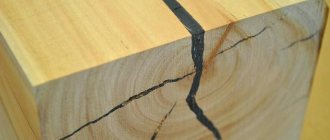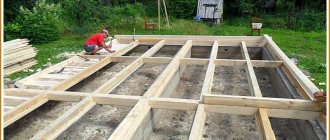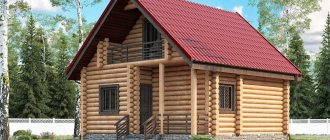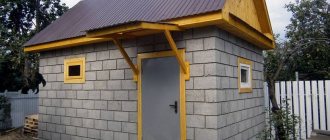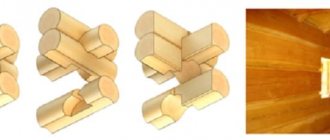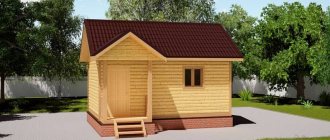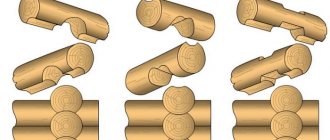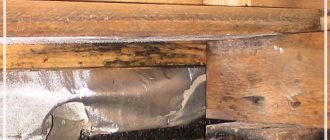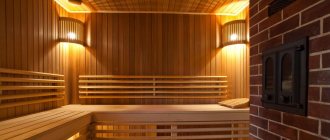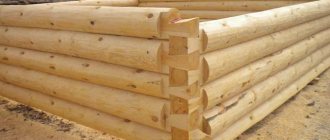Finishing a wooden house includes a number of mandatory works, of which caulking is an important part. Caulking is done several times. The first caulking is done during or immediately after the construction of the house. The second time the house is caulked after the completion of the shrinkage processes, which, depending on the type and moisture content of the wood, last from one to two years. In some cases, a log house requires a third caulking, which is performed 5-6 years after construction. Is it possible to caulk in winter? This question is relevant for many, since it is not always possible to carry out caulking during the warm period. Let's figure out when it is better to caulk a log house: in winter or summer, and why.
Projects of houses made of timber
Number of projects 687
- 4 rooms
- 2 bathrooms
Champion House Project
- To favorites
- 103² Total area
- 7 x 8m Construction area
from RUR 1,075,166
Construction time individually
- 4 rooms
- 4 bathrooms
Project Summer Guest House “Quartet”
- To favorites
- 108² Total area
- 6 x 9m Construction area
from 833,000 rub.
Construction time individually
- 2 rooms
Mushroom House Project
- To favorites
- 61² Total area
- 6 x 6m Construction area
from 437,167 rub.
Construction time individually
- 6 rooms
- 2 bathrooms
House Project No. 14081-FK
- To favorites
- 203² Total area
- 14 x 12m Construction area
from 7,137,468 rub.
Construction time individually
- 2 rooms
- 1 bathroom
House project "Scandinavia"
- To favorites
- 84.2² Total area
- 7 x 6m Building area
from RUB 701,110
Construction time 5 days
- 5 rooms
- 2 bathrooms
Anapa House Project
- To favorites
- 122.3² Total area
- 9 x 9m Construction area
from 1,430,000 rub.
Construction time individually
- 6 rooms
- 3 bathrooms
House Project MPC-1816-F0155-0337
- To favorites
- 385² Total area
from 6,774,000 rub.
Construction time individually
- 4 rooms
- 1 bathroom
Project of the House "BK 12"
- To favorites
- 156² Total area
- 11 x 8m Construction area
from 1,521,000 rub.
Construction period 50 days
- 3 rooms
- 2 bathrooms
Volgograd House Project
- To favorites
- 184² Total area
- 16 x 11m Construction area
from 6,028,487 rub.
Construction time individually
- 6 rooms
- 2 bathrooms
Camelot House Project
- To favorites
- 186.6² Total area
- 11 x 12m Construction area
from 1,970,000 rub.
Construction period 90 days
- 5 rooms
- 3 bathrooms
Angela House Project
- To favorites
- 239² Total area
- 13 x 12m Construction area
from 5,975,000 rub.
Construction time individually
- 3 rooms
Perm House Project
- To favorites
- 106² Total area
- 8 x 8m Construction area
from 880,627 rub.
Construction time individually
- 3 rooms
- 2 bathrooms
Project of the House "BK 01"
- To favorites
- 116² Total area
- 6 x 9m Construction area
from 1,131,000 rub.
Construction period 35 days
- 3 rooms
- 2 bathrooms
House project No. 55
- To favorites
- 79² Total area
- 6 x 9m Construction area
from 1,066,500 rub.
Construction time individually
- 7 rooms
- 2 bathrooms
Kedr House Project
- To favorites
- 254² Total area
- 14 x 13m Construction area
from 7,317,944 rub.
Construction time individually
- 4 rooms
- 2 bathrooms
Favorite House Project
- To favorites
- 106² Total area
- 7 x 7m Construction area
from RUB 790,759
Construction time individually
- 4 rooms
- 1 bathroom
Admiral House Project
- To favorites
- 112² Total area
- 8 x 7m Construction area
from RUB 1,334,715
Construction time individually
- 6 rooms
- 2 bathrooms
House Project No. 12124
- To favorites
- 203² Total area
- 21 x 16m Construction area
from 7,794,393 rub.
Construction time individually
- 2 rooms
- 1 bathroom
Project of the House "BK 19"
- To favorites
- 128.05² Total area
- 13 x 10m Construction area
from 1,792,700 rub.
Construction period 35 days
- 5 rooms
- 3 bathrooms
Vermont House Project
- To favorites
- 158.7² Total area
- 11 x 10m Construction area
from 2,797,000 rub.
Construction period 90 days
View all projects
Living in wooden houses made of timber is considered to be as comfortable as possible, if you do not forget about insulation measures after the building shrinks, for example, caulking.
Knowing the technologies for caulking timber, the materials for them, and understanding which method can be used in your case, you will be able to do this work quickly and correctly. The result will be a warm and cozy wooden house that meets the requirements of heat conservation and comfort.
Read on and you will learn what and how to caulk a house made of timber, as well as when to do this work, and how to do it correctly.
Caulking a wooden house - necessary after shrinkage Source satom.ru
Is it necessary to caulk a house made of timber?
When constructing timber houses, insulation is laid on each crown. Under its own weight, the log house invariably shrinks. This is a natural process and cannot be avoided. The wood dries out and changes its geometric parameters: the timber “sits”, the insulation wrinkles in places, and cracks appear. This may not be noticeable to the eye, but on average a log house 3 meters high can shrink by 10-12 cm after a year.
Gaps in timber after shrinkage Source content.onliner.by
To improve the thermal performance of a timber house, the timber must be caulked. This procedure is needed for the following purposes:
- Prevent heat leakage . During shrinkage, cracks appear between the crowns of the log house, the so-called “cold bridges”. Drafts appear and heat is blown out. Caulking allows you to retain heat and improve the thermal performance of your home.
- Elimination of icing of walls . In the absence of caulking, heat will escape through the cracks formed when the timber shrinks. Due to the difference in temperatures during the cold season, moisture entering the cracks of the timber freezes, which leads to further cracking of the wood.
- Increased home performance . After caulking, a full thermal balance will be created in the log house. Heat conservation will save resources on heating your home. The log house will be in more comfortable operating conditions in the complete absence of icing on the external and internal walls.
This is what a caulked timber looks like Source 1brus.ru
Caulking is a mandatory step in construction.
It will keep the house warm, save heating resources, and also increase the service life of the building as a whole.
Important conditions for caulking
Weather conditions in the Moscow region are quite harsh, winters can be snowy and frosty, so when choosing a time for caulking, you must consider the following:
- caulking can be done in frosty, windless weather;
- the air temperature should be no lower than 10-15 degrees; lower temperatures will not allow for high-quality caulking of the log house;
- Caulking cannot be done during snowfall, since the snow will get clogged into the inter-crown seams along with the material, which is undesirable.
If all the above conditions are met, caulking can be done in winter. But it should be taken into account that only specialists can perform high-quality caulking in difficult weather conditions.
Winter is a great time for caulking. In winter, finishers do not have such a busy work schedule as in summer; the work will be completed without haste, very carefully and accurately.
When and how many times should you caulk?
In addition to understanding how to caulk a log house, you need to know when to do the work. Wooden houses are most susceptible to shrinkage during the first year and a half of operation, then over the course of 5-6 years the shrinkage occurs slowly and fades away completely. Caulking is carried out in three stages:
- Primary . Immediately after the construction of the log house is completed. Despite the installation of inter-crown insulation, the joints are additionally sealed with the selected material. Due to the upcoming shrinkage of the house, caulking can be done with a low density.
- Secondary . Produced one year after the construction of the house. The log house will shrink by almost 80%. It is necessary to tightly caulk the cracks that appear and prevent the remaining material from hanging down.
Secondary caulk Source ytimg.com
- Third caulking . Produced 4-6 years after the start of operation of the house. The log house is caulked tightly. All joints in which the insulation has been lost over time are filled.
Double caulking is an indispensable condition for creating an ideal thermal contour of a building. The third time it is necessary to caulk if there is no external cladding of the house. If the outside of the house is insulated with finishing material, there is no need to seal the joints a third time.
Is it possible to make caulk during the rain?
In the warm season, there are also times when it is undesirable to caulk a wooden house. For example, many people wonder: is it possible to caulk in the rain? Experts do not recommend caulking in rainy weather.
When it rains, the surface of the logs and the insulation itself (jute, tow, linen, etc.) get wet. During secondary caulking, the insulation is packed very tightly, and since it is wet, wet material gets into the inter-crown seams.
Dense packing does not allow the insulation to dry out quickly; therefore, high humidity remains in the inter-crown seams for some time. Thus, optimal conditions are created for the appearance of mold, the development and reproduction of microorganisms and fungi, which ultimately leads to rotting of the wood.
Video description
Description of the “stretch” caulking technology in the video:
This technique is practiced both using natural traditional materials and modern insulation materials, and if the material is represented by a tape or roll, caulking is much easier and faster. When caulking, standard tools are used: a wooden spatula and a wooden hammer.
- “To set” method
This method is used if significant gaps larger than 5 mm in size have formed during the shrinkage of the house.
From the selected material, carefully twist the tourniquet and fold it into loops. The space between the logs is filled with rolled loops, filling wide gaps and minor cracks as tightly as possible. A special spatula and a wooden hammer are used.
Method “to set” Source galich-dom.ru
With this technique, it is recommended to use rolled tape materials, since twisting strands of fibrous materials with the subsequent set of loops is a complex matter. But in general, seams can be sealed with any materials.
Which sealant for cracks is better to choose?
Lnovatin
In order for log houses to preserve the internal microclimate, retain heat and keep out moisture and cold, they need to be specially treated - caulked, that is, plugging the cracks between the logs. When building housing, wood is placed on moss for better adhesion, but this is not enough to plug all the holes between the building materials. When drying, additional cracks form in the logs. Therefore, it is necessary to caulk the log house not only immediately during construction, but also a couple of years after construction, when the logs are completely dry and all unnecessary cracks come out.
It is very easy to caulk a log house with your own hands, using natural materials and simple tools. Common materials for log caulking are:
- flax wool;
- wool felt;
- tow;
- jute.
They have their advantages and disadvantages, knowing which you can choose the most suitable material.
Flax wool is a product of crushing and pressing flax. The material prevents the logs from rotting, but is short-lived. Wool felt is warm, but crumbly and loose. Therefore, moisture easily penetrates through the felt, as a result of which the logs are easily covered with rot. Tow can also accumulate excess moisture and cause logs to rot.
Jute is soft wood fibers gathered into a bundle. It is produced from shrubs of the linden family, growing in Asia. The wood product is the most modern and durable material compared to its plant and animal counterparts. Jute fibers are stronger than fishing line and fit together tightly enough to prevent excess moisture from entering the house.
Since this material is completely natural, it is absolutely harmless, does not emit toxic fumes and does not cause allergic reactions in the residents of the house. Unlike linen and felt, jute is resistant to rot and moths, and it protects logs from birds.
The main advantage of the material is its hygroscopicity. The fiber absorbs excess moisture from the logs, so the log house does not rot. In dry weather, jute releases accumulated moisture to the wood, so it does not crack. The disadvantage of jute is that it consists of wood fibers, and therefore reacts to changes in weather conditions in the same way as wood: it shrinks in dry weather and swells in wet weather.
Technology of caulking a house made of timber
Caulking technology consists of a certain sequence and rules for carrying out work.
First, the lower crowns are caulked; work does not begin from the middle of the frame or the upper crowns.
The work is carried out simultaneously outside and inside strictly along the perimeter of the log house.
You should begin compacting the space between the second and third crowns only when work on all four walls between the first lower crown and the subsequent second is completed. This is done to prevent the house from skewing, because after the insulation is completed, the timber may become about 10 cm higher.
Caulking can be produced using fiber and tape insulation. When caulking with tape material, the work is carried out much faster, and it is much easier to perform.
Basic principles
The quality of the log house's assembly is determined by how the crowns are laid. It is important not only to cut out the bowls and grooves correctly, but also to lay inter-crown insulation between two rows of logs or beams.
The insulation is installed during the assembly stage of the log house
What it will be - moss, tow or jute - is up to you, but such a layer must be present. When building a log house, you need to lay insulation in two layers:
- on the lower crown so that the edges of the insulation protrude beyond the edges of the bowl by 3-5 cm, the width of the insulation, in general, is taken 5-10 cm more than the width of the bowl;
- Insulation is also placed in the bowl of the upper crown; its edges protrude beyond the bowl by 3-5 cm.
Please note that when using moss or tow, there is no need to “tap” the material. When tapped with a hammer or an ax butt, the moss fibers break and dents form on the wood, which are directed across the fibers. Such damage can lead, in the future, to the development of foci of rotting. It is enough to simply compact the fibers with the palm of your hand, leveling and probing the layer; if you come across large foreign objects (cones or sticks are often found in moss), simply remove them.
Laying moss when assembling a log house
When using tape insulation, you can fix it using a construction stapler - damage to the wood from the staples is minimal, and the material is held securely. It is advisable for two people to lay the “insulated” crowns so that they can take the log from both ends and lower it so as not to move the insulation.
Video description
Caulking timber: how it happens is shown in the video:
To understand how to properly caulk a house made of timber, we will consider in detail the methods of caulking with various materials.
Caulking technology with fiber insulation:
- Moss or flax tow is applied to the gap with fibers across it, then, holding the material, it is pressed deep with force with a special spatula.
Caulking tow Source fasad-exp.ru
Video description
Caulking with rolled material: you will see how to do it correctly in the video:
The corners of the timber are caulked using the same technology:
- If the gaps are wide, a cord is formed from the insulation tape. Roll it into a ball.
- Unwind part of the cord and weave loops from it. Then each loop is pushed inside the seam.
- Hammer the loops with a spatula, first from above the joint, then from below.
- After sealing the seams, final caulking is carried out if necessary. It involves residual filling of joints and is carried out if necessary.
- The density of the caulk is checked with a kitchen knife. The knife blade should not extend into the joint more than 1.5 cm. If this condition is met, caulking is done correctly. If not, then additional caulking is required.
Checking the density of the caulk Source 24aul.ru
Caulking corners is done using the same technologies using roll insulation, for this they move along the seam from the bottom up. To ensure uniform laying of the material, it is constantly tensioned and straightened.
Definition of quality material
Flax batting is a special strip of flax fiber that is laid and hammered into the cracks between logs in wooden log houses. The size - the width and thickness of the flax, as a rule, should be chosen by the caulker - the worker who will perform this type of work on punching voids and cracks between the logs with flax. Thick and wide flax batting - 20 cm wide. It is usually used for caulking - sealing wider necks between logs. Linen batting with a width of 15 centimeters or less is used for punching medium and small cracks. Interesting information:
Briefly about the main thing
Caulking involves sealing cracks in a log house with insulating material. It is necessary to caulk the house after the timber shrinks. This must be done twice, and in the absence of outer cladding - three times.
Caulking is done using various materials. The main thing is that they meet the requirements of heat conservation, are environmentally friendly and durable in use. Traditional materials are represented by moss, tow and hemp. Modern ones - jute and linen felt.
Depending on the width of the gaps that appear after shrinkage, they can be caulked in two different ways using rolled or fibrous materials: the “stretch” method or the “set-up” method.
Ratings 0
Professional caulking in all weather conditions
ready to caulk a wooden house or bathhouse at any time of the year. Regardless of the season, the work will be done to a high quality level. The company employs professional caulkers who have special education, experience and work skills.
We guarantee excellent quality of workmanship, compliance with the deadlines specified in the contract, and cleanliness of the site. The first visit of a specialist for inspection and drawing up an estimate is free of charge.
You can leave a request and ask your questions directly on the website in the feedback form. You can also contact us in any way using the coordinates on the “Contacts” page.
Calculate the cost of painting and insulating your home right now
